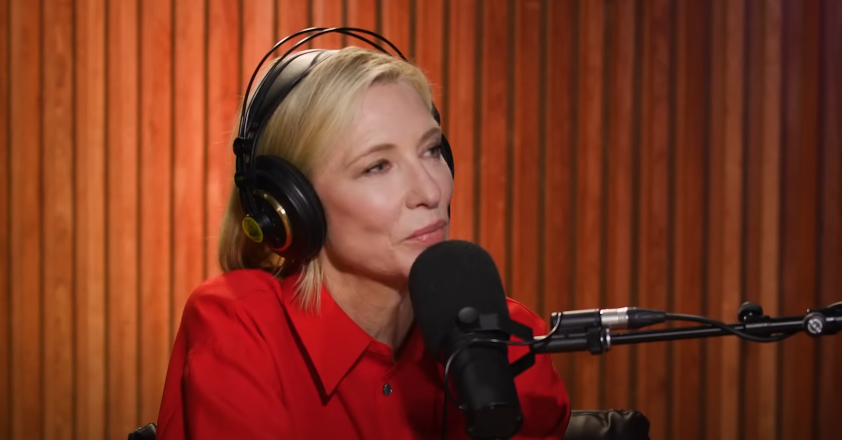Cate Blanchett is still a powerful force in film, not just because of her nuanced performances but also because of the authenticity she maintains both on and off screen. Her striking appearance in Black Bag promotional photos, where she sports vintage leather and long brunette waves, sparked a resurgence of conversation on social media. Some viewers were shocked by her changed appearance, and they made wild guesses about potential cosmetic procedures. Again, though, the actor’s metamorphosis is artistic rather than surgical.
She has made this point clear on multiple occasions. Cate has been open about her dislike of cosmetic surgery and the emotional toll that altering one’s natural features takes. Early on in their marriage, her husband, Andrew Upton, allegedly took a strong stand, joking—or perhaps warning—that surgery could be grounds for divorce. Cate has made a commitment to natural rituals rather than laser treatments or botox injections. One of the many tiny routines that keep her glowing is her daily consumption of warm lemon water, an ancient wellness practice with French and Egyptian origins.
Cate Blanchett – Detailed Profile for WordPress Embedding
| Attribute | Information |
|---|---|
| Full Name | Catherine Elise Blanchett |
| Date of Birth | May 14, 1969 |
| Place of Birth | Melbourne, Victoria, Australia |
| Nationality | Australian |
| Occupations | Actor, Producer, Theatre Director |
| Years Active | 1992–present |
| Notable Works | Elizabeth, Carol, Blue Jasmine, TÁR, The Lord of the Rings |
| Major Awards | 2 Academy Awards, 3 BAFTAs, 3 Golden Globes |
| Spouse | Andrew Upton (m. 1997) |
| Children | Four (three sons and one adopted daughter) |
| Surgery Stance | Strongly against plastic surgery; focuses on wellness and skincare |
| Reference | Us Weekly – Cate Blanchett on Plastic Surgery |
Blanchett has positioned herself as a silent revolution in a field overrun with facelifts, fillers, and filters by opting to age gracefully and visibly. Over the years, she has made remarkably consistent statements. Although she is not passing judgment on other people’s decisions, her own beliefs are based on long-standing worries, primarily regarding long-term effects. She once said, “In the end, all you see is the work,” implying that soul as well as muscle movement is lost.

Her tone in interviews has frequently been a combination of caution and empathy. In one particularly telling statement, Blanchett acknowledged that when she witnesses young women adopting cosmetic surgery too soon, she feels “pity” instead of admiration. Even though that word offended both critics and fans, it emphasized the actress’s commitment to maintaining what is authentic, despite its flaws. Her worries stem from preserving the fine details that give each face its individuality, particularly when it’s employed as a storytelling tool, rather than from moral superiority.
There has been a discernible change in Hollywood’s portrayal of beauty during the last ten years. Blanchett’s opinions have been echoed by actresses such as Emma Thompson, Rachel Weisz, and Kate Winslet. When taken as a whole, they signify a gradual but noteworthy shift toward openness and reality. Their position contradicts a tradition in which the industry has valued youth so highly that even small wrinkles on the face can put a leading role in jeopardy. These women are redefining beauty, not criticizing it.
Online speculation, however, has continued. “Before and after” pictures are still being shared on sites like Reddit and Pinterest, where users analyze angles and skin tone like facial archaeologists. Cosmetic surgeons have also entered the discussion. After examining Blanchett’s photos, Dr. Daniel Barrett—who is well-known for his TikTok commentary—came to the conclusion that there was no proof of facelifts or rhinoplasty. Rather, he commended her for what he considers to be an extremely effective skincare routine, attributing it to her genes and consistency rather than procedures.
Blanchett’s approach is refreshingly subtle in a world where social media algorithms magnify extremes. She frequently alters her appearance—not out of vanity, but for roles. Although it may have appeared drastic, her transformation in Black Bag was purposefully told. As an actor, she views her face as a flexible medium that can bend, wrinkle, and express without being constrained by chemicals, rather than a static canvas.
Blanchett’s viewpoint is especially helpful for many younger women navigating beauty standards influenced by digital perfection and influencers. She is not advocating that we forgo grooming or self-care. Rather, she’s reminding viewers that it’s acceptable—even admirable—to age fearlessly. Although it provides an alternative that is frequently overlooked by industry pressure and celebrity endorsement, her position does not minimize those who choose enhancement.
In this sense, rather than deteriorating over time, her career has significantly improved. Blanchett’s performance in TÁR demonstrated her emotional range, sensitivity, and mastery. She never gives in to the pressure that her face must stay in a static state, and she continues to be a powerful presence during awards season. Her characters have an edge because of her unvarnished and unrefined facial expressions. If anything, growing older has greatly increased the impact of her portrayals.
Blanchett has established an incredibly clear tone through her calculated decisions and unwavering sense of self: surgery is not necessary for transformation. It calls for dedication, self-assurance, and a readiness to let time do its thing. Her genuineness strikes a chord whether she’s dressed in a simple suit or a Renaissance gown.
